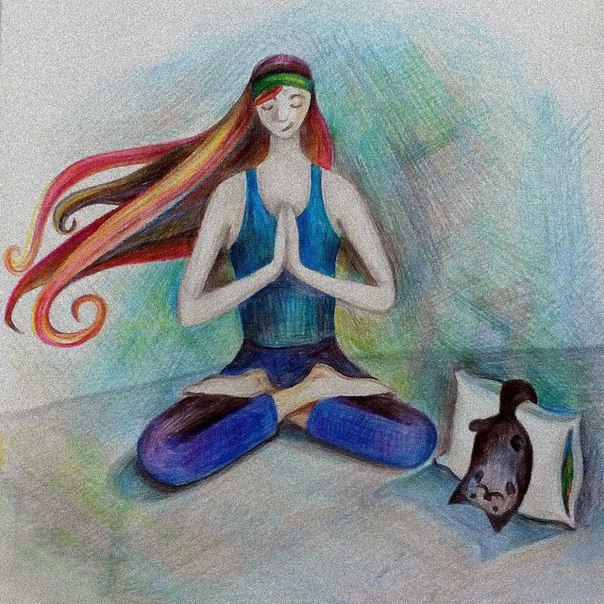As someone who tries their best to move through this world with some measure of awareness of my own thoughts and words, as well as others’ words, I have been witness to the ways that we’re all so hard on ourselves.
As a yoga teacher, the phrase I hear most from newer students is “I’m not good at yoga.”
In the context of the yoga I know, this is an impossible statement. Which brought me to the thought that it may benefit newbies and experienced practitioners alike to share what I believe yoga is not, as well as what yoga is.
Yoga is not about looking good. It is not about having a fit body for the sake of looking great in a swimsuit. A strong and flexible body is a nice byproduct of a regular yoga practice, the true goal of which is to unify the body and mind using the breath. The cause of most suffering is in the mind, particularly when it feels separate from the rest of us; yoga helps to alleviate this suffering by creating an opportunity for this body-mind connection to be reestablished.
Yoga is not mastering an incredibly advanced pose to intimidate your fellow students. Given the way that yoga has been interpreted in the west, it is easy to understand why many who are newer to yoga would think that it’s all about appearance. Right now on Instagram, there are over 20 million photos (and counting) with the #yoga hashtag, many of them exhibiting yogis in impossibly acrobatic poses with legs behind the head or videos of long-held handstands with toes touching the forehead. These poses are intended to inspire others (they certainly inspire me!) but they can be intimidating to newcomers, especially in our culture where we are often comparing and finding reasons to be so very hard on ourselves.
Yoga is not showing off your fancy new yoga pants, or the buff backside residing within. And then there are the yoga pants. Yoga is a $30 billion industry (and growing) and much of this is spent on the clothing. This is a far cry from the 1970s when most people confused yoga with “yogurt.” As Americans, we get excited about something new and because most of us have so much disposable income, we want to back that excitement up with money, buying pants, mats and props.
The explosion of yoga in our society is exciting, but the dark side of the spending aspect of this enthusiasm is that it leaves behind those with lesser means who believe there is an expensive price of entry. Also, because we are so prone to comparison and self-judgment, those new to yoga can be intimidated by those of us able to do advanced poses. I’ve seen new students get upset at advanced yogis doing beautifully executed poses on nearby mats.
Early on in my practice I was one of those frustrated new students. I didn’t understand that yoga has nothing to do with appearances at all. It’s not about clothes, props, or even the actual poses.
Yoga is a Sanskrit word which literally means “to yoke,” or to join together. Yoga is about connection, or reconnecting. Connecting the breath to the body, the body to the mind, the mind to the heart.
All the rest of it is simply window dressing, a product of our culture and its values on appearance and consumerism. And that’s okay, as long as it doesn’t create suffering in the minds of newer students, or worse, keep them from ever trying yoga.
Yoga is about how a pose feels in the body, how it opens up the lines of energy and allows for fuller, deeper, calming breath. The poses allow us to move energy and emotion through the body to calm the mind, preparing us for meditation.
At its roots, yoga was created thousands of years ago, with poses just the natural offset to a lot of meditation: picture wise men sitting in meditation for hours, then doing a few stretches before sitting again.
Yoga poses are one of the eight limbs of yoga, which start with personal and ethical observances (for example be truthful, do not be violent) and end with four steps of meditation: quieting the senses, concentration or focus, contemplation and samahdi (bliss or peace, sometimes described as the moment we unite with the divine). The poses are just preparing the body to be in a calm, connected place for this union to occur.
In yoga there is a belief that we each have a light within our heart that is the same within each of us, the divine within. When we say “Namaste” at the end of class, we’re saying “The light within me honors the light within you.” Connecting with this light is what yoga is about.
If you can breathe, you can do yoga. The breath is our life force, from our first inhale at birth to our final exhale at death. The practice of yoga for me is inhaling meaning into the breaths in between these two moments. It is connecting with that light within, and working to continuously shed the layers that build up and cover that light.
And just as yoga does not require an expensive mat or new pants, samadhi, or union with our divine light, is not some never-reached place at the top of a Himalayan mountain; it is always within.
It is always within.
Author: Rebecca Polan
Editor: Catherine Monkman
Image: meredyn/Deviantart







Read 4 comments and reply